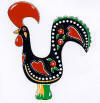
|
|
|
|
|
||
|
|
|
|
|
|
||
July, 2006
Dear "new relative,"
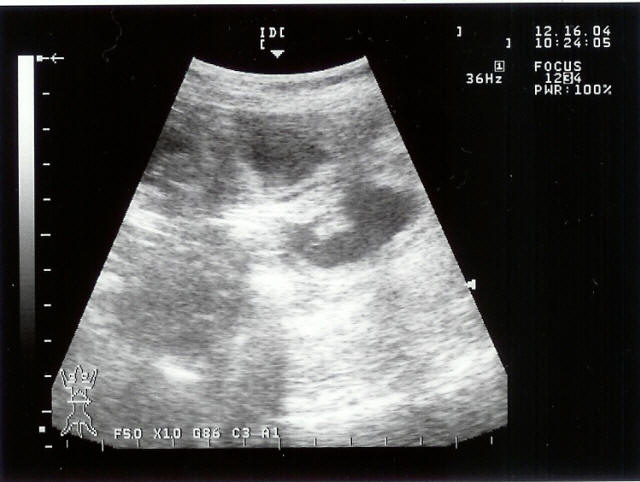
You all know how happy I am to have met you in the special breeder-owner relationship. We are mutually committed to giving your pup a great life. So let’s get to it--here is some basic information that I hope you find useful in preparing for and raising your new puppy.
 Your puppy will come with its own leash and
collar, a towel with its mom’s and littermates’ scent on it to remind
him of home for the first few days, a copy of Verne Foster’s PWD Puppy
Book, a small slicker brush, a puppy retrieving dummy, and all kinds of
paper work.
Your puppy will come with its own leash and
collar, a towel with its mom’s and littermates’ scent on it to remind
him of home for the first few days, a copy of Verne Foster’s PWD Puppy
Book, a small slicker brush, a puppy retrieving dummy, and all kinds of
paper work.
Before your pup arrives, it helps to think about some things—
Where will you put the crate for those times during the day when you can’t be directly focused on what the pup is doing?
Where will you put the crate at night? (I recommend the bedroom, next to your bed).
Where will you put the food and water bowls? (waterproof floor, accessible for drinking water when it wants, but out of the traffic flow so the pup can eat peacefully)
What spot in your yard will you designate as the potty area?
You will need when your pup arrives—
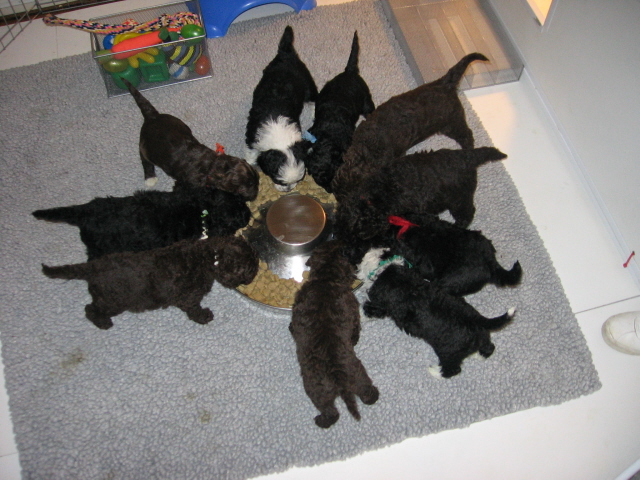
Food and water bowls
A puppy sized crate
A comb and brush
Grooming scissors, and a blunt end scissors for trimming around eyes
Puppy shampoo (tearless, and not human products--a dog’s skin pH is different)
Mild ear cleaner (Biogroom’s Eargard is excellent. Do not use powders or alcohol-based products.)
Food and treats for training
Some toys of differing textures. At this age I recommend Kongs, stuffed toys, milkers, and rope toys. I do not recommend greenies or nylabones. Right now, soft or medium vinyl toys without squeakers are good and not too hard for puppy teeth.
A nail clipper or Dremel grinder
Some Nature’s Miracle for cleaning up.
(Probably) some Bitter Apple spray to deter mouthing on forbidden objects.
I really recommend that everyone read Patricia McConnell’s "The Other End of the Leash." It has excellent information about canine human interactions.
Eventually (well, pretty soon, actually) you will want to have—
A grooming table with an arm
A dog hair dryer (human hair dryers are not powerful enough, and heat damages the coat)
Possibly (probably) a clipper for grooming or for touch ups between professional groomings (A good clipper costs about the same as 2 trips to the groomer; get a powerful one to handle the thick PWD coat).
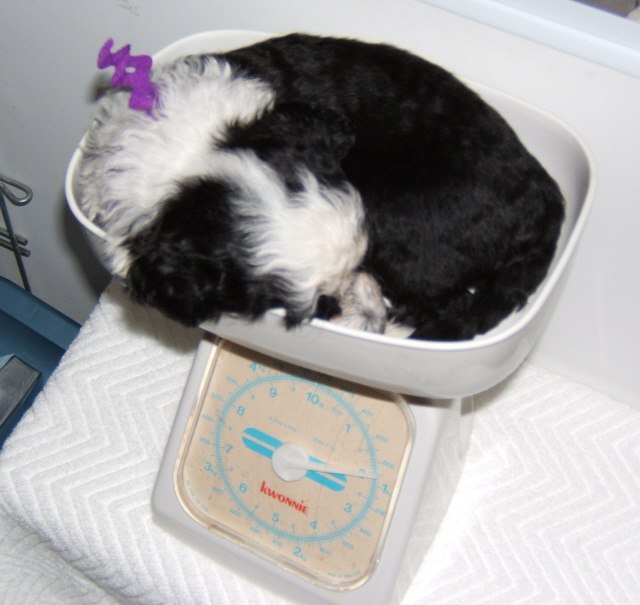
The next collection is information, presented in no particular order, which I think is valuable and is not duplicated in the puppy book or other sources.
The immune system
As you know by now, the PWD has a number of diseases and conditions related to immune system functioning. These conditions include, among others, Addison’s disease, Irritable Bowel Disorder (IBD), hypothyroidism, Cushing’s disease, food allergies, and megaesophagus.
In light of these concerns, I recommend the following regimens for raising your puppy:
The immune system needs early development to function properly in the adult dog. By providing your pup with frequent, regular, controlled, and vigorous exercise, you will increase the strength of the heart, improve the efficiency of the respiratory system, and stimulate the adrenal-pituitary system to produce stress-responding hormones. Do not coddle your puppy—cuddle, but don’t coddle! By exposing your pup in a controlled manner to physiological stresses, such as vigorous exercise, brief exposure to cold, etc., you are helping your pup to develop physically as well as mentally. Remember that this is a high- energy breed, and they need this exercise to be healthy as well as happy. See below for a discussion of exercise.
Vary the food you feed your dog. Help your pup’s digestive system to develop the ability to deal with a variety of foods. Introduce vegetables and fruits. Try oatmeal (my dogs love oatmeal!). Add cooked sweet potatoes to their diet. Vary the kibble throughout the dog’s life, especially during the first year, while avoiding corn and beef based foods. Try yogurt, milk, and cottage cheese. Whole eggs are harder to metabolize, but still a good source of nutrition, and the extra work demanded of the digestive system helps your dog develop resilience. Start with small quantities and simply observe the dog’s stool for consistency and monitor the amount of eye and ear matter for signs of tolerance.
Check before you give shots that may be unnecessary. For many reasons, the protocol for giving shots recommended by the American Animal Hospital Association and the American Veterinary Medical Association was changed in 2003. We now realize several things: that the immunity given to pups from the dam’s nursing lasts much longer than we had thought; that booster shots may not be necessary and may be harmful; that each dog has a different need throughout its life; that the improved strength of vaccines means that the dog must be older to absorb the impact on the immune system, and much more.
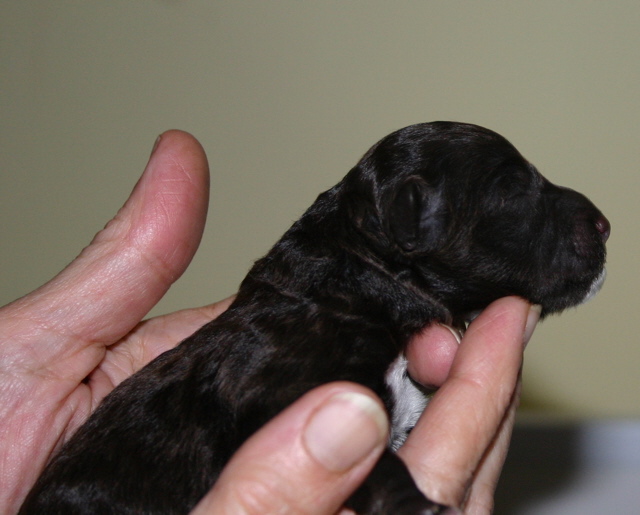
What does this mean for you?
Before you give any shot (except for rabies, which is required by law), have a blood titer done to determine exactly what your pup needs at that time, and give only that shot. Do not use combination vaccines. If your vet has difficulty obtaining single vaccinations, contact me, and I will give you ordering information.
If your pup needs more than one type of immunization, do not give any immunizations closer than two weeks apart.
If your pup is given an immunization, do not automatically give a "booster." Instead, do another blood titer to see if the pup has "sero-converted," which means formed immunity from the previous shot.
Annually, instead of automatically giving shots, have a blood titer to see what your dog needs (I know people whose dogs were 18 months old before they needed any shot, and that was for distemper only).
There are two exceptions to this recommendation. First, if you will be kenneling your dog when you go on trips, you may be required to have a "kennel cough" immunization. Kennel cough is air-borne, and contagious, and the risk is high in boarding kennel situations, so that is a prudent choice. Similarly, there is no maternal antibody passed for heartworm, and if you live in a part of the country where heartworm exists, your dog should take heartworm medication. Check with your veterinarian for when to start giving heartworm medication to your pup. Also, give only the heartworm medication, not combined with any other product such as another type of wormer.
If you want more information to discuss with your veterinarian, or for him or her to discuss with me, please see the following websites:
http://www.aahanet.org/About_aaha/About_Guidelines_Canine06.html
http://www.ivis.org/advances/Infect_Dis_Carmichael/schultz/chapter_frm.asp?LA=1
http://www.caberfeidh.com/PuppyVax.htm
http://www.knowbetterdogfood.com/dogcare/health/vaccinations.php
Miscellaneous items (some are in the contract)
Please don’t skip the fecal check after you’ve had the pup for 10 days to 2 weeks. Although your pup will be healthy when you receive it, the stress, however mild, of leaving dam and siblings and adjusting to your new home and schedule can allow dormant parasites to emerge. By checking your dog’s stool sample after the parasites have had a chance to be visible microscopically, you will be able to determine whether or not a worming medication is needed. If it is not, please don’t automatically worm your pup. An annual fecal check throughout your dog’s life, or if you see signs of a potential problem, will show whether or not you need to do so.
I’ve talked a lot about exercise. Being a late maturing breed, PWD’s growth and energy spurts really accelerate at around six months, but their muscle does not catch up with their frame for around a year and a half. Until their musculature and bone are in better balance, it is relatively easy to damage joints and ligaments. Here are some guidelines to consider.
The strongest muscle in the dog (and in humans and alligators) is the maxillo facial muscle at the jaw hinge. Since it is the strongest, it is the last to mature. When mature, its feel will change, from just "fleshy" and somewhat flat, to firmer and rounder. Muscular development throughout the dog’s body after that change occurs will result from maturity and exercise rather than from genetics.
PWDs were bred to jump, and they do--a lot. As much as possible, don’t let or encourage your pup to jump higher than its shoulder height or longer than its body length until the maxillo-facial muscle has developed. Avoid torquing, slippery surfaces, and hard surfaces such as concrete. What type of exercise is left? Fast paced walking on grass, swimming, recall games between two people, gradual uphill inclines, running that doesn’t involve sharp turns, etc.
Spay/neuter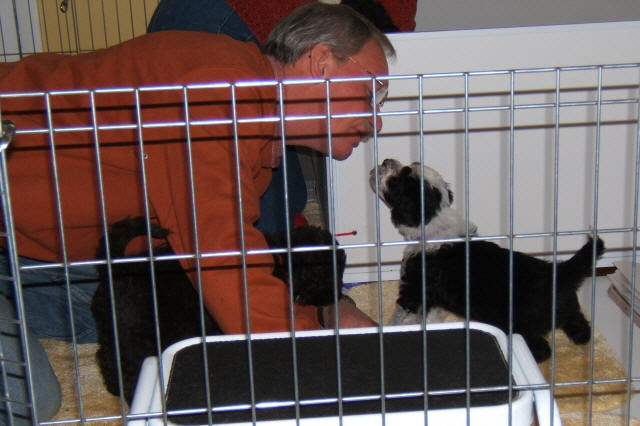
Grooming
The time that you don’t spend vacuuming will need to be spent in grooming. Your pup has been brushed, and combed regularly from the age of 5 weeks, and it has been bathed and its nails trimmed regularly.
The following points are not a grooming guide, just some practical suggestions.
This is an oily skinned, dry-coated breed. By way of explanation, this is similar to a Labrador’s skin and a poodle’s coat.
Let your nose be your guide—when the dog begins to smell doggie, it needs a bath.
Let your eyes be your guide—if you notice flakes, it more likely is oil clogging the skin pores than it is dry skin, and your dog needs a bath. Ditto if your dog’s hair clumps.
Let your fingers be your guide—when the hair feels oily, it needs a bath.
When you bathe, rinse, rinse, rinse, and then rinse again.
Brush and comb every day. Don’t be fooled by the brush feeling like it is running free—only the comb will get down to the skin.
The PWD has two coat changes—from puppy coat to adolescent coat around 6 to 9 months of age, and from adolescent coat to adult coat from around 16 to 24 months of age. During those coat change periods, you need to be extra vigilant to keep the coat free from matts.
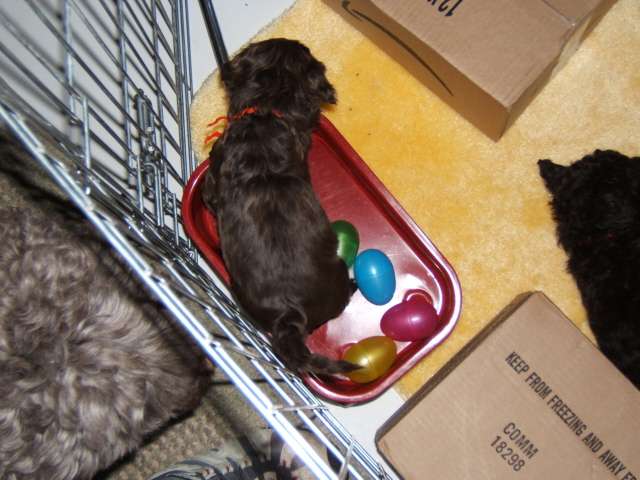 I recommend Mr. Cristal’s Australian or The
Coat Handler shampoos. For puppies, you can get a tearless shampoo
especially formulated for puppies. Do not use human products; a
dog’s skin has a different pH.
I recommend Mr. Cristal’s Australian or The
Coat Handler shampoos. For puppies, you can get a tearless shampoo
especially formulated for puppies. Do not use human products; a
dog’s skin has a different pH.
Trim the hair on the bottom of the feet that grows between the pads. You can either trim it even with the pads by laying the blades of the scissor flat on the pads and snipping, or you can groom between the pads using a blunt end scissors similar to those designed for trimming human nose hair.
Trim or Dremel the nails regularly, and check often—you won’t believe how fast they can grow. A proper length of nail is fairly straight; when it starts to curve or hook down, it’s too long.
For cleaning the ears: Skin oil collects in the bottom of the ear canal, and acts as a trap for dust. The hair then acts like a candle wick to wick up that oil and junk away from the inner ear and make it more accessible for cleaning. If you pluck all the hair, then you must wash and clean the ears more often, and then you stand the chance of drying out the more tender skin inside the ear. If you don't pluck any hair, then you don't allow sufficient air circulation.
To clean the ears, turn the earflap back and look at the hair growing in the ear. Some of it will be gunky, with dust and stuff on it. Grasp those hairs and pull them out--they have done their job of wicking up the oil from the bottom of the ear canal. Leave the rest of the hair to do the job another day. How much hair should you leave? If the convolutions in the ear are very deep or the ears are very hairy, it helps to pluck more hair (for air circulation) than if they are not as deep.
When you bathe the dog, be sure to use shampoo diluted in warm water--dribble a little into the ear, and then, on the outside, massage all around the bottom of the ear to circulate it and loosen dirt. Rinse, and rinse, and rinse. When drying the adult dog, I use an old thin cotton sock over my finger to gently mop in the ear and wipe up the loosened oil in the convolutions. For puppies, you can use a q-tip swab (don’t try to go too deep!) or cotton ball.
I check in the ears about once a week, and just grasp and pull the dirty hair out. They don't even seem to notice, so I'm pretty sure that it doesn't hurt them. If the hair is already thinned out, then use mild ear cleaner to keep them fresh.
Teething
The jaw does not start out as a solid bone, but as loose cartilage that gradually solidifies over time. It does not solidify completely until the maxillo-facial muscle has developed. For that reason, your pup’s teeth are shifting ever so slightly even after the adult teeth come in, and that means that it is experiencing low-grade, chronic discomfort. Be sure you provide lots of things for the pup to chew on—cold carrots, old washcloths that have been wet thoroughly and then frozen, kongs, etc. for at least the first year and a half of the dog’s life.
Feeding
Don’t free feed your dog (don’t leave food down all the time). Dogs are classified as "opportunistic feeders" and will eat better if food is not always available.
Don’t worry about feeding your dog at
exactly the same time every day. Varying feeding time by as much as
several hours will keep your dog from becoming complacent about
food.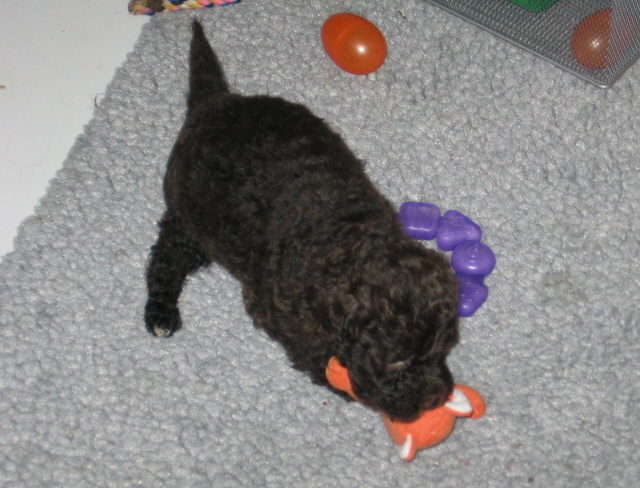
Your pup was raised on Eukenuba puppy food, with fresh veggies and dairy products added on a rotating basis (see the section on the immune system). Feed your pup three times a day until it is about 5 months old, and then gradually decrease the mid day meal, and adding to the morning and evening feedings. Of course, always have water available. Don’t be concerned if your dog eats more at one time of day than another; many dogs do this. Feed your pup enough so that it cleans its bowl or leaves a few pieces of kibble. Balance his appetite with watching the stool quality (too soft a stool can mean the pup is overeating) and weight. If a soft stool persists for a day or so after decreasing the quantity of food, consult your vet. If your pup refuses to eat for more than 24 hours, consult your vet even if no other signs of illness are apparent to you.
When you are ready to switch to an adult dog food, there are many high quality foods to choose from. As I have said, my dogs’ diet varies. I feed Eagle Pac holistic in a variety of blends, Dick Van Patton’s Natural Balance, etc. I supplement with various raw and cooked portions, such as those found in Pitcairn's Complete Guide to Natural Health for Dogs and Cats."
Please think very carefully about feeding a "bones and raw food" diet exclusively. I do not recommend it. While ancestral or wild dogs, with an average life span of only 7 years, may have crunched bones, we are seeing enough domestic pets with cracked teeth (painful, life shortening, and expensive) from gnawing on bones to question if that is a good idea.
Monitor the amount of protein matter that collects in the corners of the eyes and oily gunk in the ears to determine your dog’s compatibility with any food. Increased secretions indicate a low-grade allergic sensitivity, meaning that particular food is irritating the dog in some way.
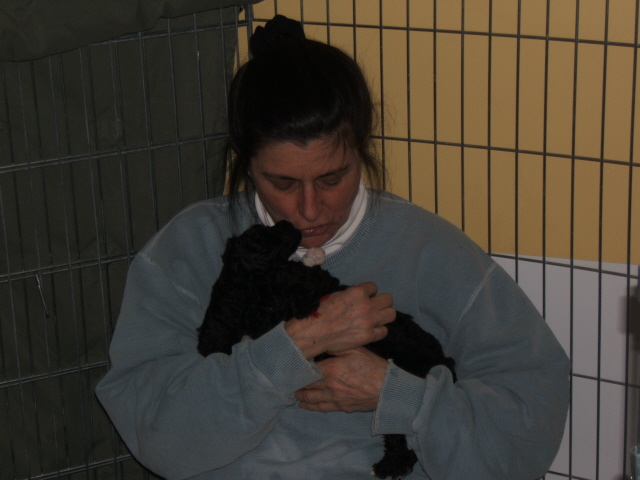
House training
Most of the pups get really good about going to the papers in their puppy pen. You can help get across the idea of going outside by putting down some newspaper in the designated potty area of your yard.
I recommend that you put a leash right by the door until the puppy is housetrained. Attach the leash to the collar, and carry the puppy to the potty area. Then put it down. Speak only about going potty or tending to business, or whatever your phrase will be. Then, and only then, play with your pup if you were planning to do so. If not, when the pup is finished, pick it back up, bring it inside (you can pet it on the way inside, but not on the way outside). If/when you need to get up during the night, get dressed first, then open up the door and pick up the puppy, carry it to the door, put on the leash, carry it out to do its business, put it back in the crate and return to bed. Resist the temptation to turn nighttime potty breaks into play times, since it encourages waking up.
Puppies do not have full bladder control until around 4 to 5 months. This means that they usually will need to eliminate at least once during the night. They also need to urinate after any change of pace—when they wake up, when they eat, when they play, when they are groomed. In addition to a fixed routine of going outside at regular times during the day, take your pup outside after any of these or other occurrences, and again at the regular time, even if it is only a short time later. Your pup will get to know and depend on the schedule. Also, as pups approach sexual maturity, they often confuse those new feelings with the need to urinate, so you may find a brief period around 6 to 8 months of age for males and before the first heat season for females when it seems they have forgotten their housetraining. They haven't; they just need to be on a puppy schedule again for a few weeks.
Manners and obedience training
Let's keep a distinction in mind. Behavior is what a dog does naturally—sit, jump, walk. Performance is when we cue the dog to sit on command, not jump on us, and walk beside us on a loose lead. Behavior is natural; performance must be trained. Remember, we want to reinforce performances that we ant and correct behaviors that we don't. This simple formula can be accomplished by rewarding performance with praise, attention, and/or treats, and correcting by ignoring (not reinforcing) activities like jumping up. Often times, a simple deep, slow "no-o-o-o" will stop a pup in its tracks.
Please do not use start out using force or compulsion training with your PWD. This is sometimes called "jerk and praise" or Koehler training. It involves a great deal of collar corrections and physical manipulations, and is not well suited to the PWD’s tendency to range and explore the limits of behavior, and desire to move itself. Keep in mind the difference between collar guidance/control and correction. Explore positive motivation, clicker training, play training, and the variety of advances in humane dog training that have become widely available in the last few years. For more information, please contact me.
Especially, please do not train with the use of
"dominant downs" wherein the pup is rolled onto its back and pinned down
until it stops struggling. They are unnecessary, totally misunderstood,
and overused. Again, please contact me to discuss why I believe this.
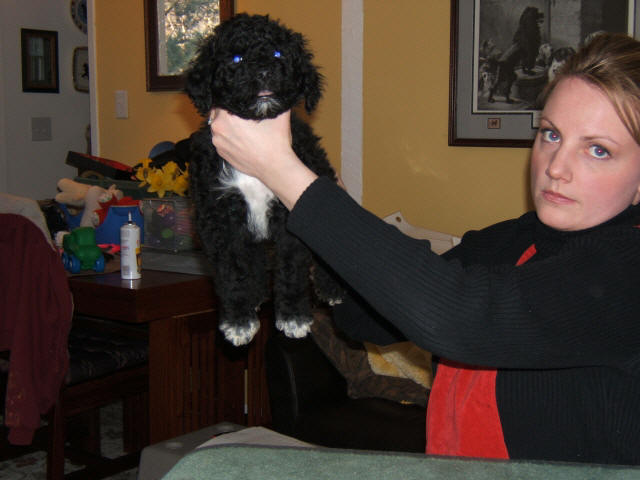
I'm not saying don't correct your puppy! Start your training the day your pup arrives, and use training appropriate to the age of the pup or dog, and be consistent.
Please remember to pet and handle your doggie all over—tail, paws, belly, ears, mouth, teeth, etc., not just when you are grooming or examining it.
Clubs and health info, data base
Welcome to my extended family! And welcome, too, to the larger family of people committed to protecting and preserving the Portuguese Water Dog. You can get huge benefits from joining the national PWD club and your local club as well. Benefits include health information, training tips, a network, a group of people with whom to share your stories, newsletters, and the inspiring and beautiful Courier magazine from the national club.These clubs also support health research and databases so we can help others to breed and raise healthier dogs by pooling our resources. Included in your puppy packet are applications for the national club, the Twin Cities local club (if you are not already a member) and a Health Registry reporting form with which to send in your pup’s very first health clearance from the CERF exam record that is also included. Please do that soon!
Speaking of people who love these dogs, included in your packet is a partial list of the folks who have helped to socialize your pup. They have spent many hours walking pups in Sherpa bags, holding, stroking, bringing them outside, playing, teaching bite inhibition, leash training, and much more. They love these pups, and I know they would love to hear from you with stories and pictures of your pup in its new home. I hope you have the time to contact them.
Always, please let me know how things are going. It is never too late at night or too early in the morning to hear from you.
Kathy and Grace
Return to home pageJuly 31, 2006